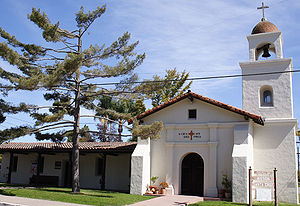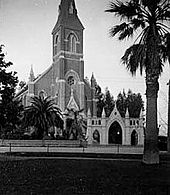- Mission Santa Cruz
-
Mission Santa Cruz 
The half-size Mission Santa Cruz replicaLocation 126 High St
Santa Cruz, California 95060Name as founded La Misión de la Exaltación de la Santa Cruz [1] English translation The Mission of the Exaltation of the Holy Cross Patron The Exaltation of the Cross [2] Founding date September 25, 1791 [3] Founding priest(s) Father Fermín Lasuén [4] Founding Order Twelfth[2] Military district Fourth[5] Native tribe(s)
Spanish name(s)Awaswas / Ohlone, Yokuts
CosteñoNative place name(s) Uypi [6] Baptisms 11 [7] Marriages 11 [7] Burials 11 [7] Secularized 1834[2] Governing body Catholic Diocese of Monterey Current use Chapel and Museum Coordinates 36°58′41.2206″N 122°1′45.8394″W / 36.978116833°N 122.029399833°W California Historical Landmark #342 Website Mission Hill Area Historic DistrictLocation: Mission Street Coordinates: 36°58′39″N 122°1′43″W / 36.9775°N 122.02861°WCoordinates: 36°58′39″N 122°1′43″W / 36.9775°N 122.02861°W Area: 38 acres (15 ha) Architectural style: Spanish Colonial, Stick-Eastlake-Queen Anne—Victorian NRHP Reference#: 76000530[8] Added to NRHP: May 17, 1976 Mission Santa Cruz was established in 1791 and named for the feast of the Exultation of the Cross, the name that the explorer Gaspar de Portolà gave to the area when he camped on the banks of the San Lorenzo River on October 17, 1769, and erected a wooden cross.[3] As with the other California missions, Mission Santa Cruz served as a site for ecclesiastical conversion of natives, first the Ohlone, the original inhabitants of the region, and later the Yokuts from the east. The settlement was the site of the first autopsy in Alta California.[4] Today, Mission Santa Cruz functions as a museum open to visitors; the replica chapel, located near the original Mission site, has weekday masses and is available for weddings and funerals. The Holy Cross Church on the site of the original church is an active parish of the Catholic Diocese of Monterey. Today's Plaza Park occupies the same location as the original plaza, at the center of the former Mission complex. The complex at one time included as many as 32 buildings.
Contents
History
The Santa Cruz mission was originally consecrated by Father Fermín Lasuén on August 28, 1791,[9] on the San Lorenzo river's flood plain. It was one of the smaller missions, in the fourth military district under protection of the Presidio of San Francisco.[5] The mission was flooded as the San Lorenzo swelled with the rains that winter. Over the next two years, the padres set out to rebuild the mission on the hill overlooking the river. The night of December 14, 1793, Mission Santa Cruz was attacked and partially burned by members of the Quirosto tribe who inhabited the mountains to the east of Point Año Nuevo. The attack was purportedly motivated by the forced relocation of Indians to the Mission. On October 12, 1812, Father Andrés Quintana was beaten to death and his body disfigured by natives angry over his use of a metal-tipped whip in the punishment of mission laborers.
In 1797, the Spanish governor of Monterey founded the secular pueblo (town) of Branciforte, across the San Lorenzo River to the south of Mission Santa Cruz. The frequent gambling and smuggling which occurred in and through Branciforte brought what the padres of Mission Santa Cruz considered an unwelcome element to the area. In 1818, the Mission received advance warning of an attack by the Argentine corsair (simply a pirate, from the Spanish point-of-view) Hipólito Bouchard and was evacuated.[10] The citizens of Branciforte were asked to protect the Mission's valuables; instead, they looted the Mission.
Decline and preservation
A series of earthquakes in 1857 destroyed the mission buildings.[9] The lands were put up for sale, but no buyer was found. In 1858, a wood-frame church was built on the old Mission property. In 1889, the current Gothic style Holy Cross Church was built on the original adobe site. There is nothing left of the original Mission except for a row of buildings which at one time housed local Yokut and Ohlone Indian families, and a protected remnant of the mission wall standing behind the current Holy Cross Church. The parish address is 126 High Street. The road leading to the mission from the west is called Mission Street; now most of Mission Street is designated part of California State Route 1.
In 1931, Gladys Sullivan Doyle proposed to construct a replica of the Mission; she used her own funds to build a half-size replica of the original church. The small chapel is mainly used for private services.
Santa Cruz Mission Historic Park and District
The only surviving original adobe mission building, a dormitory for Indian residents, has been restored as part of the Santa Cruz Mission State Historic Park as the Neary-Rodriguez Adobe.[11] The Santa Cruz Mission is designated California Historical Landmark number 342 .[12] The Neary-Rodriguez Adobe was added to the National Register of Historic Places listings in Santa Cruz County, California as site number 75000484 on February 24, 1975, and the Mission Hill Area as a United States Historic District as site number 76000530 on May 17, 1976.[8]
Notes
- ^ Leffingwell, p. 131
- ^ a b c Krell, p. 219
- ^ a b Yenne, p. 112
- ^ a b Ruscin, p. 196
- ^ a b Forbes, p. 202
- ^ Ruscin, p. 195
- ^ a b c Krell, p. 315: as of December 31, 1832; information adapted from Engelhardt's Missions and Missionaries of California.
- ^ a b "National Register Information System". National Register of Historic Places. National Park Service. 2009-03-13. http://nrhp.focus.nps.gov/natreg/docs/All_Data.html.
- ^ a b California State Historical Resources Commission. "Site of Mission Santa Cruz, California State Historical Marker". http://www.stoppingpoints.com/california/sights.cgi?marker=Site+of+Mission+Santa+Cruz&num=342&cnty=Santa+Cruz. Retrieved March 11, 2011.
- ^ There is a great contrast between the legacy of Bouchard in Argentina versus his reputation in the United States. In Buenos Aires, Bouchard is honored as a brave patriot, while in California he is most often remembered as a pirate, rather than a privateer. See Hippolyte de Bouchard.
- ^ "Santa Cruz Mission State Historic Park". California State Parks official web site. http://www.parks.ca.gov/default.asp?page_id=548. Retrieved May 23, 2010.
- ^ "Santa Cruz County". California Historical Landmark web site. California Office of Historic Preservation. http://ohp.parks.ca.gov/default.asp?page_id=21523. Retrieved May 23, 2010.
See also
- USNS Mission Santa Cruz (AO-133) — a Buenaventura Class fleet oiler built during World War II.
References
- Forbes, Alexander (1839). California: A History of Upper and Lower California. Smith, Elder and Co., Cornhill, London. http://books.google.com/books?id=NH4FAAAAQAAJ.
- Jones, Terry L. and Kathryn A. Klar (eds.) (2007). California Prehistory: Colonization, Culture, and Complexity. Altimira Press, Landham, MD. ISBN 0-759-10872-2.
- Krell, Dorothy (ed.) (1979). The California Missions: A Pictorial History. Sunset Publishing Corporation, Menlo Park, CA. ISBN 0-376-05172-8.
- Leffingwell, Randy (2005). California Missions and Presidios: The History & Beauty of the Spanish Missions. Voyageur Press, Inc., Stillwater, MN. ISBN 0-89658-492-5.
- Levy, Richard. (1978). William C. Sturtevant, and Robert F. Heizer. ed. Handbook of North American Indians. 8 (California). Smithsonian Institution, Washington, DC. ISBN 0-16-004578-9 / 0160045754, page 486.
- Milliken, Randall (1995). A Time of Little Choice: The Disintegration of Tribal Culture in the San Francisco Bay Area 1769-1910. Ballena Press Publication, Menlo Park, CA. ISBN 0-87919-132-5.
- Paddison, Joshua (ed.) (1999). A World Transformed: Firsthand Accounts of California Before the Gold Rush. Heyday Books, Berkeley, CA. ISBN 1-890771-13-9.
- Ruscin, Terry (1999). Mission Memoirs. Sunbelt Publications, San Diego, CA. ISBN 0-932653-30-8.
- Yenne, Bill (2004). The Missions of California. Thunder Bay Press, San Diego, CA. ISBN 1-59223-319-8.
External links
- Official Santa Cruz Mission State Historic Park website
- Official parish website
- Elevation & Site Layout sketches of the Mission proper
- Early photographs, sketches, land surveys of Mission Santa Cruz, via Calisphere, California Digital Library
California missions San Diego de Alcalá (1769) · San Carlos Borromeo de Carmelo (1770) · San Antonio de Padua (1771) · San Gabriel Arcángel (1771) · San Luis Obispo de Tolosa (1772) · San Francisco de Asís (1776) · San Juan Capistrano (1776) · Santa Clara de Asís (1777) · San Buenaventura (1782) · Santa Barbara (1786) · La Purísima Concepción (1787) · Santa Cruz (1791) · Nuestra Señora de la Soledad (1791) · San José (1797) · San Juan Bautista (1797) · San Miguel Arcángel (1797) · San Fernando Rey de España (1797) · San Luis Rey de Francia (1798) · Santa Inés (1804) · San Rafael Arcángel (1817) · San Francisco Solano (1823)
Asistencias
Nuestra Señora Reina de los Angeles (1784) · San Pedro y San Pablo (1786) · Santa Margarita de Cortona (1787) · San Antonio de Pala (1816) · Santa Ysabel (1818)Estancias
San Bernardino de Sena (1819) · Santa Ana (1820) · Las Flores (1823)Categories:- Historic districts in California
- Spanish missions in California
- History of Santa Cruz County, California
- California State Historic Parks
- California Historical Landmarks
- 1791 establishments
- Properties of religious function on the National Register of Historic Places in California
- Roman Catholic Diocese of Monterey in California
- Buildings and structures in Santa Cruz County, California
- Queen Anne architecture in California
- Victorian architecture in California
- Parks in Santa Cruz County, California
- Museums in Santa Cruz County, California
- History museums in California
- Religious museums in California
- Santa Cruz, California
Wikimedia Foundation. 2010.



